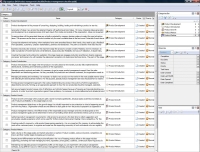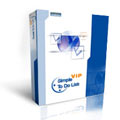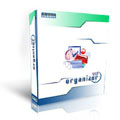|
Task Management Software |
 |
|
|
|
|
| |
|
 TESTIMONIALS TESTIMONIALS
|
|
"...This is an excellent program. I'm so glad that I stumbled on to this when researching for task management programs. Very low learning curv, quite flexible, and the price is right. Tried at least 20 other programs, either too complicated, too expensive, or poor documentation..."
Chad Lindsey -
Honolulu, HI
|
|
|
|
|
|
|
|
Product management checklist |
|
|
|
|
|
|

 |
This product management checklist will be helpful to any person who was assigned to the role of product manager and who would like to study what the product lifecycle is, what stages does it include, what the main tasks for every stage are, etc. This checklist can be used as a roadmap template to clarify the guiding principles –how the product should be managed on different lifecycle stages to cope with the essential challenges and to avoid or overcome possible issues.
|
| Order 750 checklists in MS Word and PDF printable format at $49.99 USD only. |
BUY NOW!  |
Product Development:
- Product development is the process of conceiving, designing, building, testing and maintaining a product or service.
- Generation of ideas: new product development begins with gathering product ideas – for many companies ideas generation and development is an ongoing process which gets inputs from inside and outside of the organization. Ideas can be gained through brainstorming, focus groups, systematical collecting of uncoordinated suggestions, etc.
- Screening ideas: all the generated ideas are critically evaluated by company decision-makers to select the most attractive items. This process can be done in rounds to isolate only the most workable ideas at the last round. Potential of each idea is usually evaluated in terms of sales capability, production costs, profits, competing potential, and some other factors.
- Concept development and testing: when marketers have some smoothed ideas in their hands, they need to get a feedback from specialists, customers, company stakeholders, partners and distributors. The point is to identify what they like and dislike in current concept, what are their visions, level of interest in purchasing the product, also it is important to estimate how much customers are potentially willing to spend to acquire the product.
- Business and production analysis: on this important stage the product’s concept is mainly finalized, and it is necessary to make a projection of market size and overall demand, study production feasibility and ways of realization, evaluate risks, calculate production and operational costs, make financial forecasting on sales and profits, study if product fits company’s mission and strategy, etc.
- Creating the project and putting into realization: this stage massively engages production practitioners (mainly engineers and senior technicians) who will translate the elaborated conception into determined technical terms. The point of this stage is to create, prove and accept the new business plan for production. Usually mass production begins with creating a limited lot of samples which are strenuously tested to improve the project and production processes.
Product Introduction:
- Product Introduction is the stage when the product is not only placed on the market, but also fully implemented into distributional, marketing and maintaining systems of the organization.
- Managing product contracts and sales: it is necessary to get a proper support from the sales department and distributing partners. As they practically link production and ultimate customers, the organization needs to ensure their all-round training on new product’s traits and features, to instruct them on new product ideas and specificity, to explain new marketing strategy and decide how to integrate the new product(s) into current contracts.
- Managing advertising and marketing: it is necessary to deploy new product on the market in the most suitable manner along with selecting the best business moment. For this purpose, special services should perform a massive marketing research to analyze the current situation in the market and economy, study current competitors, their plans and technologies. After this research delivers certain results, the organization’s policy should be aligned with them, so the product can get appropriate branding and then launched to market through appropriately planned marketing and advertising campaigns.
- Forming approach: this is about implementing new product into activity of all the organization’s departments and units, forming up an appropriate approach to how the new product(s) should be managed, operated, maintained, supported, controlled, etc. On this stage the official description can be created and spread among administrators and managers of all levels to explain them the new product policy and to give guidelines on how this product is supposed to be handled and positioned.
- Get secured against product misuse: lots of defections and refunds happen because of misusing and misunderstanding new products. In order to protect organization against these problems, it is necessary to create deliberated and detailed tutorials which can explain and illustrate how the product should be used correctly.
Product Growth:
- Product Growth is the stage when product’s sales volume increases significantly, because public awareness increases as well. Product’s profitability on this stage begins to rise.
- Objectives: on the growth stage it is critically important to stay attentive to what is happening around and with the product. Organization should set and adhere to clear goals on how the product’s popularity is supposed to grow and how increasingly the demand is supposed to respond to the proposition. Plans should be attentively compared with the actual situation, identifying success according to certain indicators (KPI).
- Metrics: the effectiveness of the responsible product manager and the overall progress on the goals can be determined in terms of controlling certain direct and indirect metrics such as revenue growth, customer satisfaction rate, different financial metrics, number of product’s defects, customer complaints/questions/defections, and many other indicators which can be combined to get a proper picture.
- Gathering requirements: while product is growing it is the best time to collect suggestions and accumulate valuable experience which can be used for further product improvement making it more competitive. For this purpose, organization should establish the cross-departmental expert group which will gather, systematize, analyze, prioritize and address ideas, suggestions, challenges and data on what should be reformed and improved.
- Creating product’s community: while product keeps gaining popularity, it is very important for company to acknowledge the most active customers/users, to organize and supervise the supporting community of such enthusiasts who can regularly contribute their personal experience, opinion, suggestions and ideas on how to make product better, and spread positive product’s image in the society.
Product Mature:
- Sales volume on this stage peaks and market saturation is reached. Product is stable, costs are lowered, competitors are known and their number keeps increasing up to maximum.
- Keeping brand differentiation and feature diversification: the way of keeping product afloat on this stage includes supporting, promoting and wise managing its brand, reputation, pricing policy, audience, continuously improving product’s features, designing new models, discovering new markets, designing advantageous marketing propositions and so on.
- Maintaining and adjusting profile: on this stage you can experiment with methods, trying different ways to reform strategy and align it with the latest market challenges, using previously obtained experience to maximize profits during the mature period along with securing organization’s good reputation while doing everything possible to delay the period of product decline.
- Creating conception of the product’s “successor”: the most of products, especially technological products, sooner or later come to their decline. In order to keep driving the business smoothly, organization should use the time while existing product(s) prospers to work at totally new product which can replace and succeed the current product, inheriting its best qualities and offering new ones.
- Using support of product’s community: assistance and help provided to organization by its product’s community should be continuously acknowledged and rewarded. Community’s communications and channels can be used to collect and promote ideas for the product-successor which is supposed to be launched to replace the current version.
Product Decline:
- It is the final stage of product’s existence: costs are counter-optimal, sales volumes are quite stable, but tendency of their reducing is patently forecasted, prices and profits decrease.
- Identifying and handling reasons: when some product looks “sick” it is necessary to identify the real background for its condition. Cross-departmental group of experts including marketers, manufacturers, financiers and other related specialists should be formed to consider reasons why product is not prospering anymore and to give appropriate recommendations. Probably sings of decline are temporal, caused by some external factors, or perhaps it is already the time to remove the product from the market.
- Managing distribution: when the product comes to stage of decline, making profits from it becomes a challenge of production/distribution efficiency, than a question of increasing sales. In other words it becomes harder to sell the product, so distributors should do their best to get the product sold. In these conditions it is necessary to provide distributors and vendors with the most flexible and advantageous terms giving them as much of trade space as only possible.
- Realizing the product-successor: it is necessary to prepare the new product which can succeed the previous one while it is not completely obsolete. The strategy of introducing and implementing the new product should be coordinated with the strategy of the old product eliminating.
- Eliminating the obsolete product: when product is not sellable anymore it should be completely removed from the production, making it a “museum piece” and freeing production capacities for new products. If some amount of products remains in organization’s inventory, they should be eliminated at any reasonable price. However, if product yet has some sales potential it can be modified, re-branded and redirected to the market to have the second life. Also, the product’s conceptions, technologies and other proprietary attributes can be sold to third party organizations.
| Order 750 checklists in MS Word and PDF printable format at $49.99 USD only. |
BUY NOW!  |
|





 |
CentriQS Tasks Management Solution 
Looking for multi-user task management software? Try CentriQS complete task management solution for planning, tracking and reporting tasks, projects, and schedules. Increase productivity of your small business or office by better organizing your employees' tasks and time.
 FREE Download CentriQS FREE Download CentriQS
|
|
|
|
|
|
|
|
|
|
CentriQS  -15% OFF -15% OFF |
All-in-one business management software
for small and midsize enterprises |
 |
|
|
| VIP Task Manager |
Multi-user project management software
to plan, schedule and track project tasks. |
 |
|
|
| VIP Checklists
|
More than 750 ready-to-use to-do lists
to plan your personal and business life |
 |
|
|
| VIP Team To Do List |
Professional task management software
to make and send team todo lists by email |
 |
|
|
| VIP Organizer |
Personal time management software
to organize time at home and at work |
 |
|
|
| VIP Simple To Do List
|
Simple and effective to-do list software
to plan daily chores, trips, wedding, etc. |
 |
|
|
|
|
|
|
|